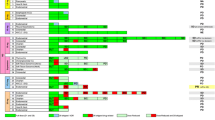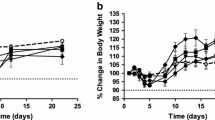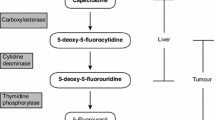Abstract
Aims: This Phase II study was conducted to determine the efficacy and toxicity of 9-nitro-camptothecin (9-NC) in patients with previously treated metastatic breast cancer. Pharmacokinetic samples were obtained to investigate the correlation of plasma 9-NC exposure with clinical response and toxicity. Patients and methods: Eligible patients had histologically confirmed metastatic breast cancer with measurable or evaluable disease. Patients must have received one or two prior chemotherapy regimens for metastatic disease. 9-NC was given orally, 1.5 mg/m2/day for 5 days each week; response was assessed every 8 weeks. Pharmacokinetic samples were obtained on day 1 of weeks 1 and 5. Results: Eighteen patients were enrolled between September 1999 and May 2000; seventeen patients were evaluable for response. The most common toxicities were nausea, vomiting, urinary symptoms, fatigue and diarrhea. No objective responses were observed; six patients had stable disease. 9-NC apparent clearance ranged from 0.57 to 55.08 L/h (median 5.91 L/h); 9-NC area under the curve ranged from 38 to 2130 ng/ml×h (median 377 ng/ml×h). There was no relationship between pharmacokinetic parameters and individual patient toxicity. Conclusion: 9-NC has limited activity in patients with previously treated metastatic breast cancer. Though 9-NC has substantial pharmacokinetic variability in this patient population; no correlation was found between pharmacokinetic variables and toxicity.
Similar content being viewed by others
References
Landis SH, Murray T, Bolden S et al.: Cancer statistics, 1998. CA Cancer J Clin 48(1): 6–29, 1998
Harris J, Lippman ME, Morrow M, Osborne CK (ed.): Diseases of the Breast. Lippincott Williams & Wilkins, Philadelphia, 2000, 755
Blum J, Jones SE, Buzdar A, LoRusso P, Kuter I, Vogel C, Osterwalder B, Burger H, Brown CS, Griffin T: a multicenter Phase II trail of Xeloda (capecitabine) in paclitaxel refractory metastatic breast cancer. J Clin Oncol 17(2): 485–493, 1999
McLeod H, et al.: Topoisomerase I and II activity in human breast, cervix, lung and colon cancer. Int J Cancer 59: 607–611, 1994
Gerritts CJ, DeJong MJ, Schellens JH, Stoter G, Verweij J: Topoisomerase I inhibitors: The relevance of prolonged exposure for present clinical development. Br J Cancer 25: 49–58, 1983
Gottlieb JA, Guarino AM, Call JB: Preliminary pharmacologic and clinical evaluation of camptothecin sodium (NSC-100880). Cancer Chemother Rep 56: 103–105, 1972
Moertel CG, Schutt AJ, Reitemeier RJ, Hahn RG: Phase II study of camptothecin (NSC-100880) in the treatment of advanced gastrointestinal cancer. Cancer Chemother Rep 56: 95–101, 1972
Amorino GP, Hercules SK, Mohr PJ, Rothenberg ML, Choy H: Enhancement of radiation effects in vitro by the orally active camptothecin analog, RFS2000 (9-nitro-20(S)-camptothecin). Proc Am Soc Clin Oncol 18: 449, 1999 (Abstract 1733)
Pantazis P, Kozielski AJ, Vardeman DM et al.: Efficacy of camptothecin congeners in the treatment of human breast carcinoma xenografts. Oncology Res 5: 273–281, 1993
Moulton S, Pantazis P, Epstein JS, Sadaie: 9-Nitroamino-camptothecin inhibits tumor-necrosis factor-mediated activation of the human immunodeficiency virus type 1 (HIV-1) and enhances apoptosis in a latently infected T-cell clone. AIDS Res Human Retroviruses 14: 39–49, 1998
Verschraegen CF, Natelson EA, Giovanella BC: A phase I clinical and pharmacological study of oral 9-nitrocamptothecin, a novel water-insoluble topoisomerase I inhibitor. Anti-Cancer Drugs 9: 36–44, 1998
Natelson EA, Giovanella BC, Verschraegen CF, Fehir KM, Delpolyi PD, Harris N, and Stehlin JS: Phase I clinical and pharmacological studies of 20-(S)-camptothecin and 20-(S)-9-nitrocamptothecin as anticancer agents. Ann New York Acad Sci 803: 224–230, 1996
Ikeda H, Koshiba R: A pilot study of irinotecan hydrochloride for metastatic breast cancer - efficacy as a salvage therapy. Jpn J Cancer Chemother 27(5): 723–727, 2000
Perez EA, Hillman DW, Mailliard JA, Ingle JN, Ryan JM, Fitch TR, Rowland KM, Kardinal CG, Krook JE, Kugler JW, Dakhil SR: Randomized phase II study of 2 schedules of irinotecan (PT-11) for patients with refractory metastatic breast cancer (MBC): An NCCTG Cooperative Group study. Proc ASCO 21:52a, 2002 (Abstract #206)
Author information
Authors and Affiliations
Additional information
Supported in part by a Career Development Award from the American Society of Clinical Oncology
Rights and permissions
About this article
Cite this article
Miller, K.D., Soule, S.E., Haney, L.G. et al. A Phase II Study of 9-Nitro-Camptothecin in Patients with Previously Treated Metastatic Breast Cancer. Invest New Drugs 22, 69–73 (2004). https://doi.org/10.1023/B:DRUG.0000006176.84915.71
Issue Date:
DOI: https://doi.org/10.1023/B:DRUG.0000006176.84915.71




